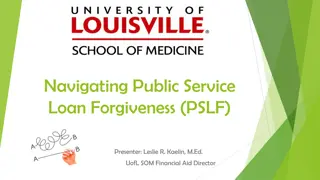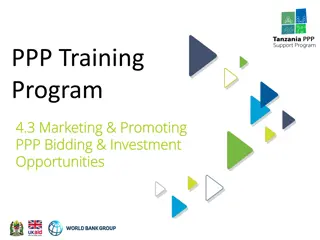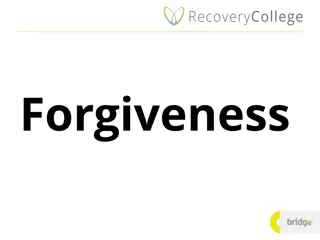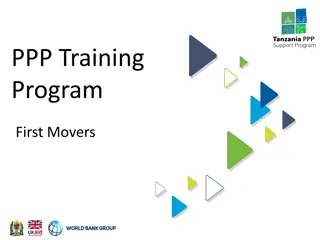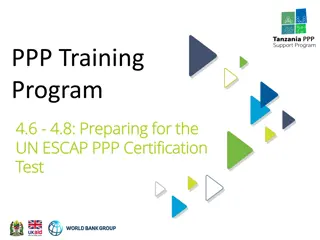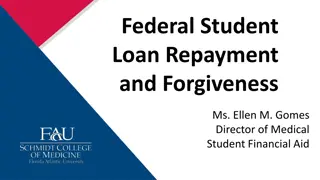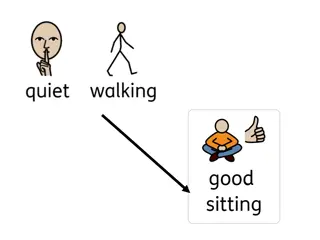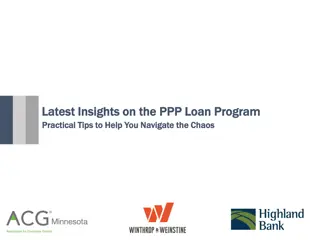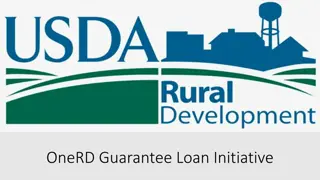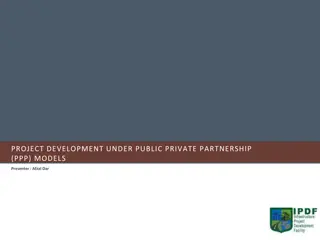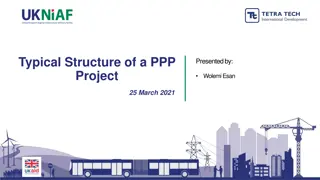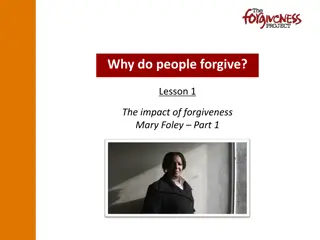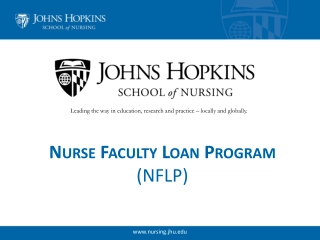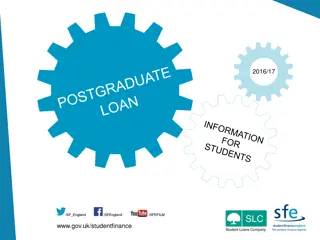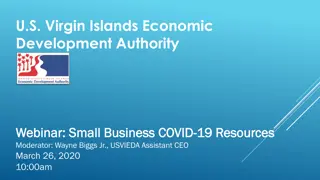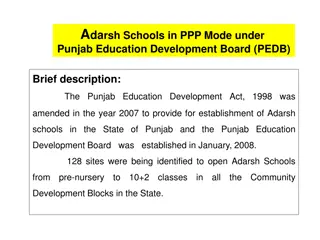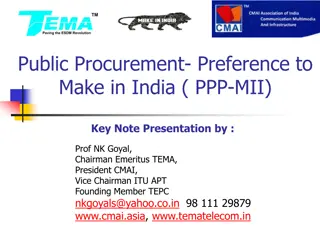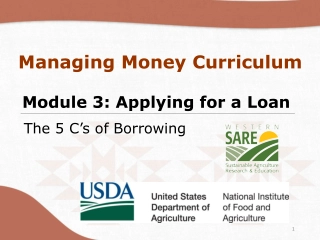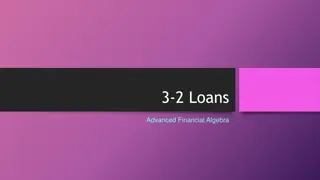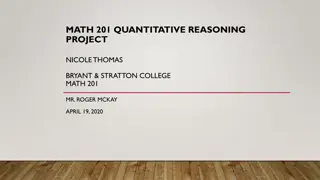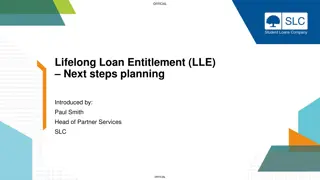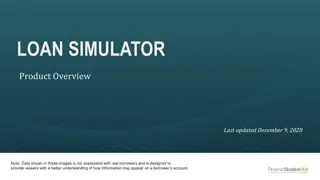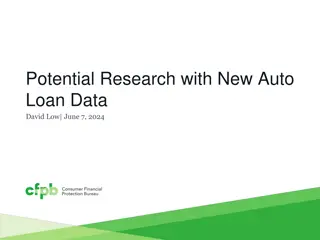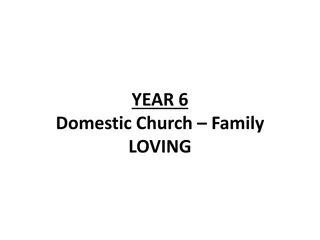Understanding PPP Loan Forgiveness Application Process
Delve into the intricacies of the PPP loan forgiveness application and the associated changes brought to the program. Explore the general formula for determining forgiveness, calculating payroll and nonpayroll costs, considerations for cash and non-cash compensation to employees, and more essential aspects for a successful forgiveness process.
Download Presentation

Please find below an Image/Link to download the presentation.
The content on the website is provided AS IS for your information and personal use only. It may not be sold, licensed, or shared on other websites without obtaining consent from the author. Download presentation by click this link. If you encounter any issues during the download, it is possible that the publisher has removed the file from their server.
E N D
Presentation Transcript
The Nuts and Bolts of PPP Forgiveness A DEEP DIVE INTO THE PPP LOAN FORGIVENESS APPLICATION AND THE CHANGES IT BROUGHT TO THE PROGRAM RON GARDNER DADY & GARDNER, P.A. RKGARDNER@DADYGARDNER.COM
General Formula for Determining Forgiveness (4 Steps) 2 Calculate Payroll and Nonpayroll Costs. (Lines 1-4) Review Potential Forgiveness Reductions for Full-Time Equivalents (FTE) and Salary/Hourly Wage Issues. (Lines 5-7) Determine Potential Forgiveness Amounts. (Lines 8-10) Arrive at Forgiveness Amount. (Line 11)
Calculate Payroll and Nonpayroll Costs 3 Payroll Costs. (Line 1) Nonpayroll Costs. (Lines 2-4)
Line 1: Payroll Costs Calculations 4 Cash Compensation to employees (up to $15,385/employee): Includes gross salary, gross wages, gross tips, gross commissions, paid leave (vacation, family, medical or sick leave, not including leave covered by the Families First Coronavirus Response Act), and allowances for dismissal or separation. Non-Cash Compensation to employees: Includes employer contributions for health insurance, employer contributions for employee retirement plans, and employer paid state and local taxes assessed on employee compensation (e.g., state unemployment insurance tax).
Line 1: Payroll Costs Calculations 5 Compensation to Owners (owner-employees, a self- employed individual, or general partners). Who are they? Capped at $15,385 for each individual OR the 8 week equivalent of their compensation in 2019, whichever is lower. Owner-Employees eligible for retirement and healthcare if not a Schedule C filer or a General Partner. Schedule C filers and GPs NOT eligible for any additional forgiveness for payment of benefits.
Line 1: Payroll Costs Considerations 6 Alternative Payroll Covered Period Available for borrowers with a biweekly (or more frequent) payroll schedule. Start your 8 week/56 day period on the first day of the first pay period AFTER you PPP money was disbursed. Allows you to sync your 8 week period to your pay schedule.
Line 1: Payroll Costs Considerations 7 Incurred/Paid Issues Payroll costs incurred before Covered Period but paid during Covered Period. Instructions for Line 1 say to enter payroll costs incurred OR paid during CP or APCP. But definition section says incurred ANDpaid. Payroll costs incurred during Covered Period but paid after Covered Period. Expressly allowed, if paid on or before the next regular payroll date. This means no stub periods will likely be required.
Line 1: Payroll Costs Considerations 8 Example Loan disbursed on Tuesday, April 14. Pay Period is bi-weekly, with one week lag to pay day. Pay period ended on Friday, April 10, with payday on Friday, April 17. First pay period AFTER disbursement begins on Saturday, April 25.
Line 1: Payroll Costs Considerations 9 Choice Standard Covered Period will run from April 14 (Disbursement date) for 56 days to June 8. This would cover paydays on April 17, May 1, 15, and 29. Also covers pay period ending on June 5 and paid on June 12. Can also pay employees with forgivable funds for work though June 6 though June 8 IF paid on June 12. Essentially payroll costs include all payroll between March 28 thru June 8. Total of 73 days.
Line 1: Payroll Costs Considerations 10 Choice Alternate Covered Payroll Period will run from April 25 (start of 1st payroll period after Disbursement date) for 56 days to June 19. This would cover paydays on May 1, 15, 29 and June 12 and work done though 19th, and paid on June 26. Here, payroll costs include all payroll between April 25 and June 19. Total of 56 days. WATCH OUT!! Signals point to more guidance coming.
Lines 2-4: Business Mortgage Interest, Rent/Lease, and Utility Payments Calculations 11 Covered mortgage interest/rent obligations Payment of interest only, no prepayment on mortgage interest/rent. Must have been in force prior to February 15, 2020. Covered utility payments Payments for a service for the distribution of electricity, gas, water, transportation, telephone, or internet access which began prior to February 15, 2020.
Lines 2-4: Business Mortgage Interest, Rent/Lease, and Utility Payments Considerations 12 Incurred/Paid Issues Eligible nonpayroll cost must be paid during the Covered Period OR incurred during the Covered Period and paid on or before the next regular billing cycle. Mortgage/rent obligations incurred before Covered Period but paid during Covered Period. Mortgage/rent obligations incurred during Covered Period but paid after Covered Period. Eligible nonpayroll costs cannot exceed 25% of the total forgiveness amount. Alternative Payroll Covered Period does NOT apply to nonpayroll costs.
Potential Forgiveness Reductions 13 Salary/Hourly Wage Reduction FTE Reduction
Salary/Hourly Wage Reduction 14 Only for employees who were compensated at an annualized rate of less than or equal to $100,000 for every pay period in 2019 or are new employees in 2020. Applies to applicable employees whose salaries or hourly wages were reduced by more than 25%.
Salary/Hourly Wage Reduction 15 3 Steps determine if pay reduced more than 25%; determine if safe harbor applies; and if necessary, determine reduction.
Salary/Hourly Wage Reduction Step One 16 For EACH employee, determine if their pay was reduced by more the 25%. Compare the average annual salary or hourly wage during the chosen covered payroll period to the annual wage or hourly wage between 1/1/20 and 3/31/20. If you paid at least 75% of the comparison period in the covered period, no deduction. If you paid less than 75%, you must go to the next step.
Salary/Hourly Wage Reduction Step Two 17 Determine whether you have qualified for the Safe Harbor. Compare the employee's annual salary or hourly wage on February 15, 2020, to their average annual salary or hourly wage between 2/15/20 and 4/26/20. If the average number for the period is equal or greater than the February 15 number, go to Strep Three to determine forgiveness deduction. If the average number is less than the February 15 number, compare the February 15 number to the average annual salary or hourly wage as of June 30. If the June 30 number is equal or greater than the February 15, you qualify for the safe harbor and will have no deduct for that employee. Otherwise, go to Step Three.
Salary/Hourly Wage Reduction Step Three 18 Here is the calculation for the actual deduction: Multiply the average annual salary or hourly wage between 1/1/20 and 3/31/20 by .75. Then, subtract the average annual salary or hourly wage from the covered payroll period. This is your BASE NUMBER. Then
Salary/Hourly Wage Reduction Step Three 19 If the EE is an hourly worker Determine the average number of hours worked per week between 1/1/20 and 3/31/20. Multiply this number by your BASE NUMBER. Multiply that number by 8. The answer is the amount of deduct attributable to that employee.
Salary/Hourly Wage Reduction Step Three 20 If the EE is a salaried worker: Multiply your BASE NUMBER by 8. Divide this amount by 52. The answer is the amount of deduct attributable to that employee.
FTE Reduction 21 How to calculate FTEs two choices: All 40+ hour employees count as 1.0 FTE. For each part-time employee, figure out the average number of hours they work per week in the Covered period. Divide that number by 40 and round to the nearest tenth. Add all of those numbers together, including the 1.0s for full time employees, and that is your FTE number; or Count all of your 40+ hour employees as one FTE each and all part-time employees as .5 each and add together. This gives you your average FTE. Compare average weekly FTE of chosen reference period (either 2/15/19 to 6/30/19 OR 1/1/20 to 2/29/20) to the average weekly FTE during Covered or Alternative Covered Period.
FTE Reduction 22 No FTE penalty for employees who: reject good-faith, written offers to be rehired and you report such rejection to your state unemployment office; were fired for cause or resigned; or voluntarily requested and received a reduction of their hours. BUT cannot double count. If position was refilled, cannot count new employee and old employee.
FTE Safe Harbor 23 Applies if: Reduced FTE levels in period from Feb. 15, 2020, to April 26, 2020; and Restored FTE levels by not later than June 30, 2020 to its FTE employee levels in pay period that included February 15, 2020.
Determine Potential Forgiveness Amounts and Arrive at Forgiveness Amount 24 Perform 3 calculations: (payroll costs + nonpayroll costs salary/hourly wage reductions) * FTE reduction Total PPP loan amount Divide payroll costs by .75 Forgiveness equals the smallest of the three calculations.
25 Certifications Information and back-up material are correct You have submitted or are maintaining required records The forgiveness amount sought was used for allowable purposes The information is consistent with your tax filings SBA reserves right to investigate submission to Lenders and your documents including docs related to initial eligibility and/or forgiveness.
26 Final Thoughts DO NOT attempt this alone! Use your advisors or get professional help. WAIT until at least June 30 to apply for forgiveness. WATCH for additional guidance. QUESTIONS?? contact@dadygardner.com
27 Helpful Resources Application https://www.sba.gov/sites/default/files/2020-05/3245- 0407%20SBA%20Form%203508%20PPP%20Forgiveness%20Application.pdf SBA Interim Final Rule https://www.sba.gov/sites/default/files/2020-05/IFR%20Forgivenss%20FINAL.pdf


